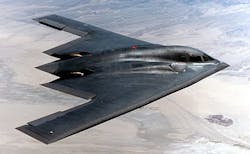Air Force eyes fuselage-mounted laser weapons to defend bombers from missiles and aircraft
Albuquerque, N.M., 12 Jan. 2011. U.S. Air Force researchers are working with high-energy laser weapons experts at TAU Technologies LLC in Albuquerque, N.M., to develop technologies that eventually may lead to 100-kilowatt laser weapons mounted to the skin of jet bombers and other combat aircraft to defend them against missiles, unmanned combat aircraft (UCAV), enemy jet fighters, and other threats.
Scientists at the Directed Energy Directorate of the Air Force Research Laboratory at Kirtland Air Force Base, N.M., are awarding a $2.7 million contract to TAU Technologies to perform laboratory research such as computer modeling and similar experiments to develop phased array laser beam control solutions for 100-kilowatt high-energy laser weapons that conform the fuselages of bomber aircraft. The contract is part of the Air Force Beam Projection & Compensation (BP&C) program.
TAU Technologies experts will try to develop laser weapons technologies that provide ultra-responsive, wide cones of beam coverage with acceptable diffraction-limited performance. Air Force researchers are particularly interested in high-resolution imaging, target-based phase sensing to combine the HEL beams coherently at the target, wavefront sensing, beam projection, and system-level beam control architectures.
TAU researchers will consider atmosphere, target acquisition, pointing, and tracking in their research work for the Air Force. The goal is to realize scalable beam control architectures to enable a 100-kilowatt fuselage-conformal high-energy laser weapons able to defend bomber aircraft from enemy attack.
TAU's work will include computer-based modeling and simulation, laboratory experimentation, and field testing and evaluation. TAU experts will develop new and innovative approaches to phased arrays, including controls, optical design, target and atmospheric modeling using a wave-optics code, and opto-mechanical design and analysis.
For more information contact TAU Technologies online at http://tautechnologies.com, or the Air Force Research Lab's Directed Energy Directorate at www.kirtland.af.mil/afrl_de.
